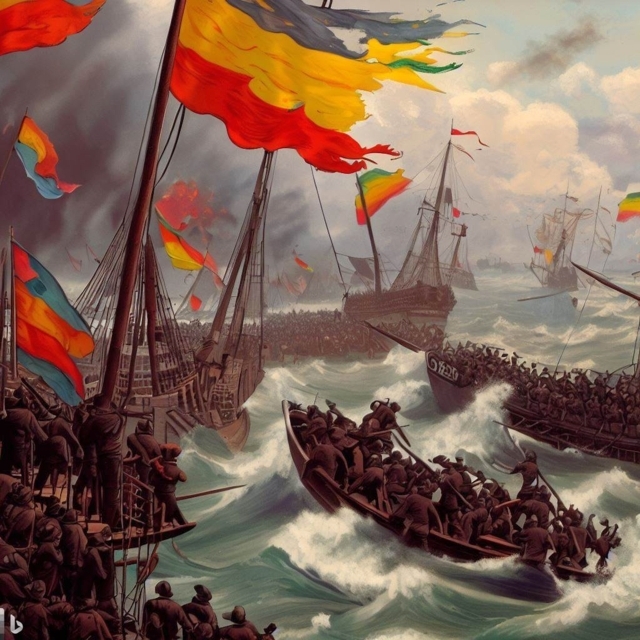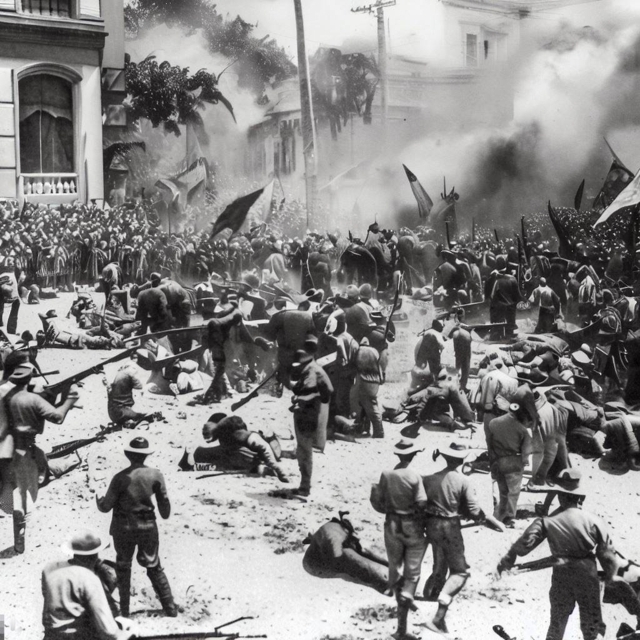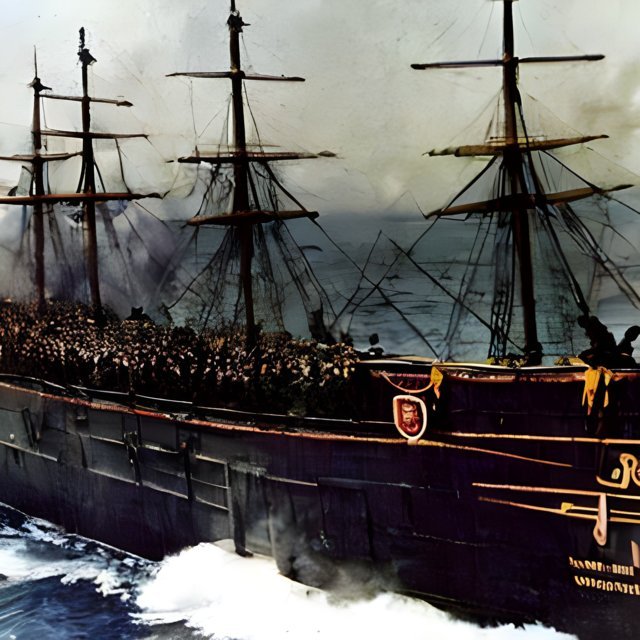On 22 November 1910, a group of sailors on board the Brazilian battleship Minas Geraes staged a mutiny against their white officers, who had been subjecting them to brutal whippings and lashes as a form of punishment. The mutiny soon spread to other ships in the navy, including the dreadnought São Paulo, the cruiser Bahia, and the coastal defence ship Deodoro. The rebels, led by João Cândido Felisberto, a black sailor nicknamed the “Black Admiral”, threatened to bombard Rio de Janeiro, the capital city, unless their demands were met. These included the abolition of corporal punishment, better pay and living conditions, and respect for their human dignity. The revolt, known as the Revolt of the Lash (Revolta da Chibata), was one of the most significant events in Brazilian history, as it exposed the racial and social tensions that plagued the country at the dawn of the 20th century.
Background of the Revolt
The Revolt of the Lash was not an isolated incident, but rather the culmination of decades of discontent and frustration among the lower ranks of the Brazilian navy. The majority of these sailors were black or mixed-race, many of them former slaves or their descendants. Slavery had been abolished in Brazil only in 1888, after a long and bitter struggle by abolitionists such as Joaquim Nabuco. However, emancipation did not bring equality or justice for the black population, who faced discrimination, poverty, and violence in a society dominated by white elites.
The navy was one of the few institutions that offered some opportunities for black men to advance their social status and acquire skills. However, they also faced harsh conditions and treatment on board the ships, where they were subjected to a rigid hierarchy and discipline imposed by white officers. Corporal punishment, such as flogging with a whip or a lash (chibata), was still widely used in the navy, despite being banned in most other countries and in the rest of Brazil. The sailors had to endure humiliating and painful punishments for minor or arbitrary offences, such as talking back to an officer, smoking, or being late for duty. The whippings often left scars and wounds on their backs, reminding them of their slave past.
The navy also underwent a process of modernisation at the turn of the century, as Brazil sought to become a regional power and compete with other nations. The government invested heavily in acquiring new and powerful warships from Europe, such as the dreadnoughts Minas Geraes and São Paulo. These ships were equipped with advanced technology and weaponry, but also required more skilled and trained personnel to operate them. Many sailors were sent to England to learn how to handle these ships and then sail them back to Brazil. There they witnessed a different social and political environment, where trade unions, labour movements, and civil rights were more developed and respected. They also realised how outdated and unacceptable their conditions in the Brazilian navy were.
The Course of the Revolt
The spark that ignited the revolt was a particularly brutal flogging that took place on 16 November 1910 on board Minas Geraes. A sailor named Marcelino Rodrigues Menezes was sentenced to 250 lashes for insubordination by his commanding officer. This was ten times more than the maximum allowed by navy regulations. The punishment was carried out in front of the whole crew, who watched in horror as Menezes was whipped until he fainted. His back was so badly injured that he had to be taken to hospital.
This incident outraged many sailors, who decided to take action against their oppressors. They organised secret meetings and planned a strategy to seize control of their ships and demand reforms. They chose João Cândido Felisberto as their leader, a veteran sailor who had served in several ships and had travelled abroad. He was respected by his peers for his intelligence, courage, and charisma.
On 22 November 1910, at 10:00 am, the revolt began. The sailors on Minas Geraes killed or wounded several officers who resisted them and took over the ship. They hoisted a flag with the words “Viva a Liberdade” (Long Live Freedom) and fired their guns as a signal to other ships. They were soon joined by São Paulo, Bahia, and Deodoro. The rebels had at their disposal some of the most powerful weapons in Latin America, capable of destroying Rio de Janeiro if they wished.
They sent a letter to the government stating their demands and giving an ultimatum: if their demands were not met by noon on 25 November, they would start shelling the city. They also declared their loyalty to the Brazilian Republic and their respect for the law and order. They claimed that they were not rebels, but patriots who wanted to end the “slavery” that was practised in the navy.
The government was caught off guard by the revolt and faced a dilemma: how to deal with the rebels without provoking a bloodbath or a civil war. The president, Hermes da Fonseca, favoured a military solution, and ordered the loyal ships and forts to prepare for an attack on the mutineers. However, he faced opposition from some of his ministers and from Congress, who feared the consequences of such a move. They argued for a diplomatic solution, and appointed a former navy captain, José Carlos de Carvalho, as their envoy to negotiate with the rebels.
Carvalho managed to establish contact with João Cândido and persuade him to accept an amnesty for all the participants of the revolt, as well as the abolition of corporal punishment in the navy. On 25 November, Congress passed a bill granting these concessions, and the president reluctantly signed it. The revolt was over, and the sailors returned to their duties.
Aftermath of the Revolt
The Revolt of the Lash was a remarkable event that shook the foundations of Brazilian society. It was one of the first and largest revolts led by black people in Latin America, and it challenged the racial and social hierarchy that prevailed in Brazil. It also showed the power and potential of collective action and resistance against oppression and injustice.
However, the victory of the rebels was short-lived and bitter. The government soon reneged on its promise of amnesty and persecuted many of the sailors involved in the revolt. Hundreds of them were arrested, tortured, or killed in prison. Others were discharged from the navy or sent to remote regions in the Amazon, where they had to work as rubber tappers or soldiers. João Cândido himself was imprisoned and tortured, and later contracted tuberculosis. He was released in 1912, but he never returned to the navy. He lived in poverty and obscurity for most of his life, working as a fisherman or a harbour worker.
The Revolt of the Lash also had an impact on Brazilian politics and culture. It contributed to the downfall of President Hermes da Fonseca, who was impeached in 1912 for his involvement in another military revolt. It also inspired many writers, artists, and activists who portrayed or commemorated the revolt in their works. Some examples are Jorge Amado’s novel Sea of Death, Candido Portinari’s painting The Naval Revolt, and Aldir Blanc’s song Admiral Black.
The Revolt of the Lash remains a significant episode in Brazilian history, as it reveals the contradictions and conflicts that marked the transition from slavery to freedom, from monarchy to republic, from tradition to modernity. It also reminds us of the courage and dignity of those who fought for their rights and their humanity.
References
– Morgan, Zachary R. Legacy of the Lash: Race and Corporal Punishment in the Brazilian Navy and the Atlantic World. Indiana University Press, 2014
– Scheina, Robert L. Latin America’s Wars: The Age of the Professional Soldier, 1900–2001. Potomac Books Inc., 2003
– Toplin, Robert Brent. The Abolition of Slavery in Brazil. Atheneum, 1975
– Revolt of the Lash – Wikipedia. https://en.wikipedia.org/wiki/Revolt_of_the_Lash
– João Cândido Felisberto – Wikipedia. https://en.wikipedia.org/wiki/Jo%C3%A3o_C%C3%A2ndido_Felisberto
– Revolt of the Lash | Military Wiki | Fandom. https://military-history.fandom.com/wiki/Revolt_of_the_Lash
– Project MUSE – Legacy of the Lash. https://muse.jhu.edu/book/35474
– Year of the Lash – Wikipedia. https://en.wikipedia.org/wiki/Year_of_the_Lash
– A Revolta da Chibata – ‘The Revolt of the Lash’, November 22nd 1910. https://blog.twmuseums.org.uk/a-revolta-da-chibata-the-revolt-of-the-lash-november-22nd-1910/
– Brazilian battleship Minas Geraes – Wikipedia. https://en.wikipedia.org/wiki/Brazilian_battleship_Minas_Geraes
Tags
Divi Meetup 2019, San Francisco
Related Articles
Unappreciated Greatness
Life and Legacy of Jahangir of the Mughal Empire. Jahangir ruled over one of the largest empires in human history during his lifetime, yet few people outside of South Asia have heard of him. I aim to shed light on the life and legacy of this remarkable figure,...
The Plague Doctor’s Diary
A Personal Account of the Turin Epidemic of 1656. I am writing this diary to record my experiences and observations as a plague doctor in Turin, the capital of the Duchy of Savoy, during the terrible epidemic that has afflicted this city and its surroundings since the...
The Timeless Beauty of Bustan
Unveiling the Secrets of Saadi Shirazi's Masterpiece.In the realm of Persian literature, few works have captured the essence of love, spirituality, and morality quite like Bustan (The Orchard) by Saadi Shirazi. This 13th-century masterpiece has left a lasting impact...
Stay Up to Date With The Latest News & Updates
Explore
Browse your topics of interest using our keyword list.
Join Our Newsletter
Sign-up to get an overview of our recent articles handpicked by our editors.
Follow Us
Follow our social media accounts to get instant notifications about our newly published articles.









